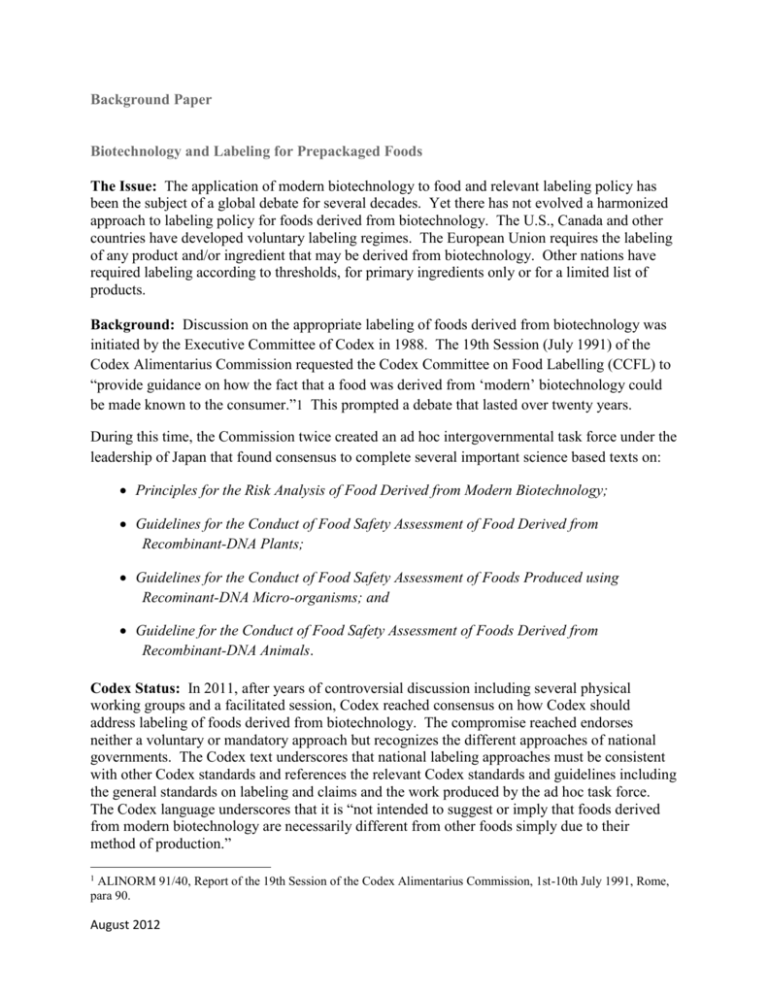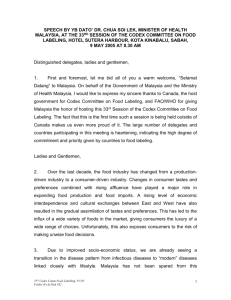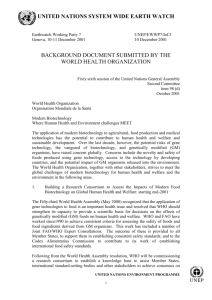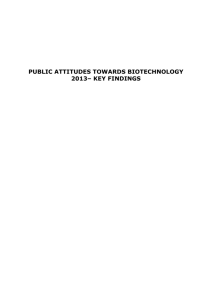Biotechnology and Labeling for Prepackaged Foods
advertisement

Background Paper Biotechnology and Labeling for Prepackaged Foods The Issue: The application of modern biotechnology to food and relevant labeling policy has been the subject of a global debate for several decades. Yet there has not evolved a harmonized approach to labeling policy for foods derived from biotechnology. The U.S., Canada and other countries have developed voluntary labeling regimes. The European Union requires the labeling of any product and/or ingredient that may be derived from biotechnology. Other nations have required labeling according to thresholds, for primary ingredients only or for a limited list of products. Background: Discussion on the appropriate labeling of foods derived from biotechnology was initiated by the Executive Committee of Codex in 1988. The 19th Session (July 1991) of the Codex Alimentarius Commission requested the Codex Committee on Food Labelling (CCFL) to “provide guidance on how the fact that a food was derived from ‘modern’ biotechnology could be made known to the consumer.”1 This prompted a debate that lasted over twenty years. During this time, the Commission twice created an ad hoc intergovernmental task force under the leadership of Japan that found consensus to complete several important science based texts on: Principles for the Risk Analysis of Food Derived from Modern Biotechnology; Guidelines for the Conduct of Food Safety Assessment of Food Derived from Recombinant-DNA Plants; Guidelines for the Conduct of Food Safety Assessment of Foods Produced using Recominant-DNA Micro-organisms; and Guideline for the Conduct of Food Safety Assessment of Foods Derived from Recombinant-DNA Animals. Codex Status: In 2011, after years of controversial discussion including several physical working groups and a facilitated session, Codex reached consensus on how Codex should address labeling of foods derived from biotechnology. The compromise reached endorses neither a voluntary or mandatory approach but recognizes the different approaches of national governments. The Codex text underscores that national labeling approaches must be consistent with other Codex standards and references the relevant Codex standards and guidelines including the general standards on labeling and claims and the work produced by the ad hoc task force. The Codex language underscores that it is “not intended to suggest or imply that foods derived from modern biotechnology are necessarily different from other foods simply due to their method of production.” 1 ALINORM 91/40, Report of the 19th Session of the Codex Alimentarius Commission, 1st-10th July 1991, Rome, para 90. August 2012 Industry Engagement: ICGMA and other industry NGOs were very outspoken on this issue. Industry agrees that for consumers buying packaged foods, the label is the single most important resource because it contributes to their first impression about the product and it communicates information that helps them make their purchase decisions. Labels list essential information such as ingredients and quantities, describe features, give instructions, explain benefits, and deliver advisories and warnings. Information considered critical to health and safety is mandated by law to appear on the label. Nonetheless, the amount of material that can be incorporated on a label is limited by its size and by the ability of consumers to absorb information. The label cannot tell every consumer everything he or she might want to know about every product, because consumers have different priorities. Label space must effectively convey material information about nutrition, ingredients and safe use. Unnecessary information on a label can drown out critical messages, or worse, confuse consumers. Over a century of experience at regulatory agencies around the world has yielded the basic elements of successful consumer protection regulation. The legal system should prohibit product claims that deceive consumers. It should expect manufacturers to have the evidence appropriate to substantiate claims that they make The protection of the consumer requires essential information to be displayed on labels of foods including such basics as the quantity, ingredients, nutrition and appropriate use of the contents of a package. A label that effectively meets the needs of targeted consumers may also communicate other information. That information may be voluntary in nature but any claims A sound labeling policy can and should recognize the rights of consumers to a safe and nutritious food supply, while facilitating consumer choice based on meaningful information about the product itself. A policy should mandate essential information and allow voluntary claims about modern biotechnology that are accurate and can be substantiated. The language adopted by Codex in 2011 does not guarantee that national governments will not mandate labeling for foods of biotechnology but should ensure that labeling is accurate and truthful, does not create an erroneous impression of the character of the food and that principles of risk analysis are considered. International Council of Grocery Manufacturer Associations 1350 I (Eye) Street, N.W. Suite 300 Washington, DC 20005 USA tel: +1 (202) 337 9400 · fax: +1 (202) 337 4508 August 2012







